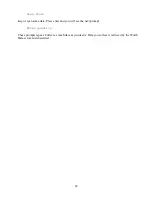
Here are some sample command statements utilizing some of the programming tips offered above:
@2,1,1,ENTER ITEM NO
Display ENTER ITEM NO on line 2, position 1
and wait for wait for data input. This is a valid
single command statement – it ends with a
data entry request.
@V23@1,2,1,WRONG ITEM
Play voice message 23, display WRONG ITEM
on line1, position 2 and wait for data input. This is
a valid multiple command statement – it ends
with a data entry request.
@C1@1,7,0,PICKING
Clear line 1. Display PICKING at position 7 of
line 1. This statement is illegal. To be a valid
statement, it must end with a data entry
request. For example:
@C1@1,7,0,PICKING@2,7,1,ITEM
@1,1,1,ITEM@2,1,1,QTY
Since only one command can be a “prompt” data
entry request, this is an illegal statement and
would be ignored as a command. It would be
valid if changed to @1,1,0,ITEM@2,1,1,QTY
Terminal to Host Formats
The basic format of a message that is transmitted from Terminal to Host is simple:
Byte position Function
Possible values
1
Data Transmitted
**
Last
Termination of
message
CR (ASCII 13)
Typically, the Terminal is sending the “answer” to the hosts “question” - for example, if a Host sent a
message to a terminal that said:
@1,1,1,ITEM NUMBER
+ EOT
The RF Terminal would display ITEM NUMBER on line 1, position 1 and accordingly, the operator would
then enter an item number by scanning or using the keypad. The RF Terminal transmits the data entered -say
it’s
123
- to the host:
123
+CR
Where
123
is the data and
CR
is the termination, (the plus sign is not transmitted).
Besides data, there are other messages that the Terminal will send to
the Host:
Serial Reply
After a
Serial
command (
@S
) has been successfully completed, the Terminal sends to the Host a CR. Serial
commands are typically used for attached serial printers. Serial commands cannot be combined with other
commands in a message to the Terminal. Remember, you can only send 231 characters (including the 0 +
@S + EOT).
SIGN ON
To login to the host computer, the user presses a key on the RF Terminal at power-up to get to the SIGN ON
screen. As the user SIGNs ON, the Terminal sends the following SIGN ON message to the host:
75






























